If you were passing through Cairo’s Tahrir Square on Saturday, you may have heard loud music blasting from the American University in Cairo’s (AUC) old campus overlooking the square as the AUC launched its centennial celebrations.
The AUC’s iconic building, sitting quietly since the university moved to its new campus in New Cairo 10 years ago, has now been transformed into the Tahrir Cultural Centre (TCC), a vibrant cultural space in the heart of Cairo.
To its thousands of alumni, the Tahrir campus represents AUC as they knew it. “Coming back for the celebrations felt as though I had never left,” said Ghada, a graduate from the 1990s.
In the building’s renovated Ewart Hall, where the old wooden seats are now covered in blue velvet upholstery, the guests were greeted, as students have been for the past 100 years, by English poet Alfred Lord Tennyson’s words, “Let knowledge grow from more to more, but more of reverence in us dwell” scripted above the stage.
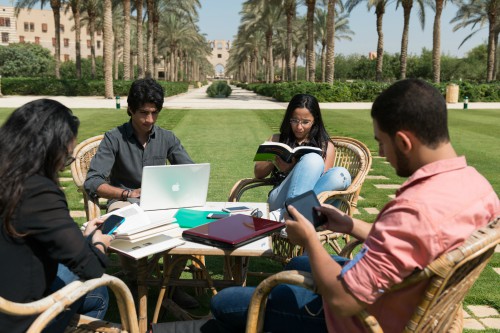
Students at the new campus
“Throughout the last 100 years, the AUC has been a rising star in Egypt’s higher education system and a proud contributor to the country’s intellectual life and connectivity to the rest of the world,” AUC President Francis Ricciardone said in his address from the Ewart Hall stage.
That same stage witnessed famous singers like Um Kolthoum in 1930 and Edith Piaf in 1949. To the pleasure of the invitees, songs by both women were re-enacted by young singers Mai Farouk and Rola Zaki to the sound of an orchestra led by Hisham Gabr.
The celebration was attended by Egyptian and international dignitaries, public figures and members of the media, as well as by the university’s board of trustees headed by Chairman Richard Bartlett.
Among those present was AUC president from 1963 to 1969 Thomas Bartlett whose tenure saw the expansion of the Tahrir campus and the acquisition of the Greek campus a block away.
Before the AUC moved to New Cairo, students could be seen scurrying between the two campuses down Mohamed Mahmoud Street to get to classes on time. The Greek campus was turned into a technology park in 2013.
Among those present for the celebrations was AUC economics professor Adel Beshai, who enrolled in the university in 1959 and graduated in 1963 with a double major in economics and political science.
He remembers paying LE50 for his first semester there, but was eligible for a scholarship throughout the remainder of his studies due to his outstanding achievement. At the time, he said, a villa in Maadi cost around LE4,000.
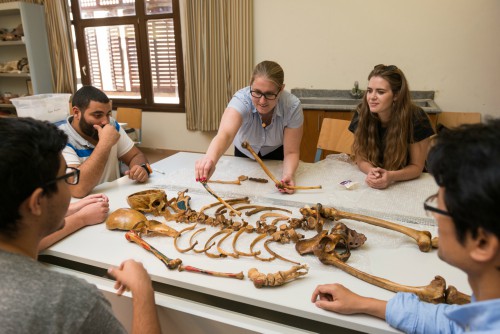
Students at the new campus
Looking at the purchasing power of the pound today, that sum was very similar to the tuition today, he said. The university’s fees, around LE150,000 (around $9,000) per semester for an arts major, are among the highest in Egypt.
The floatation of the Egyptian pound in 2016 saw tuition double, costing many parents more than they could afford to put their children through the AUC even with financial aid from the university.
“But it was worth it,” said Amal Mahmoud whose daughter graduated in January. According to a press release from the AUC, the university awards more than $24 million annually in scholarships and financial aid.
These include the public school scholarship programme that targets top-performing graduates of Egyptian state schools and the empower scholarships for students from governorates in Upper Egypt.
The secret to the AUC, Beshai said, is its liberal arts education, which contributes to creating a well-rounded individual. Students attending the University were always after a good education, he said, pointing out that the university was only accredited by the government in 1975.
However, he said, over the past few years, something has unfortunately changed in Egyptian society in that some students are not really interested in learning but are only after a certificate.
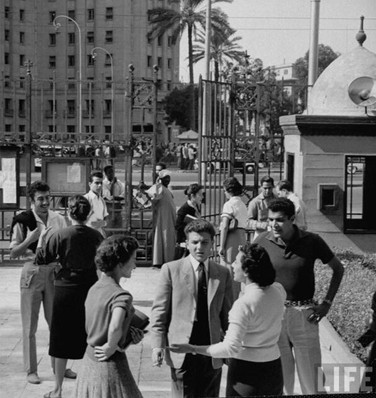
Old campus gate overlooking Tahrir Square
The AUC Today
The AUC today has six schools: humanities and social science, business, global affairs and public policy, science and engineering, the graduate school of education and continuing education. It offers 36 undergraduate majors, 44 graduate programmes, and two PhD programmes.
However, the university’s graduates, AUCians as they call themselves, say the AUC is not just about formal education. “What distinguishes AUC is the network of people it has created across the years, not only in Egypt but also across the globe,” said Mohamed Fathi, a 1999 graduate of computer science.
“It is always easy to spot a familiar face from university years. Even if we no longer remember names, the fact that we are all AUC alumni is a conversation starter,” he said.
AUC has 38,386 alumni, about 65 per cent of them in Egypt and 8,000 in the US.
Over the past few years, social media has helped to connect these alumni. Various Facebook groups now bring together AUC alumni not only to reminisce about the good old days, but also to share common interests, hunt for and offer job openings, or bring together the AUC community in distant lands.
Businessman Naguib Sawiris, addressing the invitees, also praised the role of the AUC in providing qualified individuals for Egyptian companies. Sawiris, who supported the establishment of the TCC, said that “nothing promotes a country like its youth, and nothing helps youth like culture.”
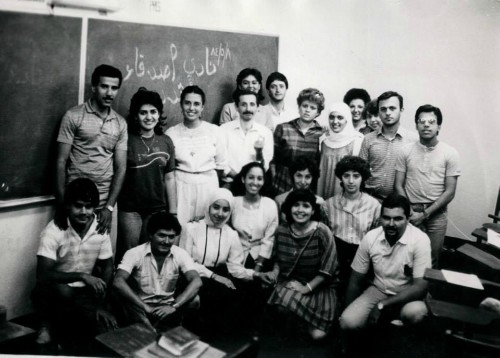
One of the club meetings in 1984
Fully owned, operated and programmed by the AUC, the TCC will host a variety of events ranging from live music and art exhibitions to book clubs.
“We are keen to offer a wide range of cultural offerings that cater to the taste of all,” Ali Mourad, TCC director, told Al-Ahram Weekly.
He stressed that the new centre was a cultural hub for all Egyptians and that it was not intended to promote any specific culture. “We want it to be a beacon of the arts, a place which provides an opportunity for different artists to present their work and for all Egyptians to take in that art,” he said.
He hoped the centre’s location in the heart of Cairo in a set of historic buildings would help it to achieve that purpose, adding that the AUC centennial celebrations were the ideal moment to launch the TCC but work had had to be completed in the record time of three months for that to happen.
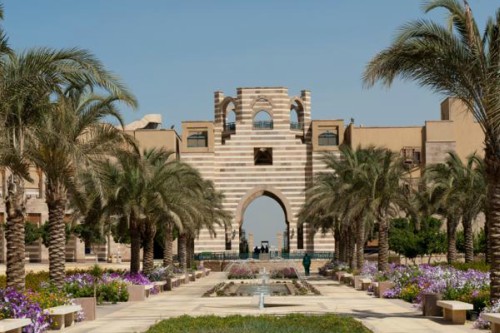
The new campus
The AUC has overlooked Cairo’s Downtown area for nearly 150 years. The main building was constructed in the 1870s by the khedive Ismail to house his confidant minister of education Ahmed Khairy Pasha, after whom the building is named.
Sold to Greek businessman Nestor Gianaclis after Khairy’s death, the building was briefly used as a cigarette factory where Gianaclis made and packaged his famous Helmar tobacco products.
In 1908, the Egyptian University, later King Fouad University and later still Cairo University, rented the building until 1919 when it was bought by Charles Watson, AUC’s founding president.
The launch of the centennial celebrations also saw a performance by the AUC’s folklore group, which performed to a packed Ewart Hall with the surplus standing at the sides and back of the hall to catch a glimpse, much like performances during assembly hours when the campus was used by students.
Ewart Hall has hosted prominent local and international figures, including literary scholars Taha Hussein and Edward Said, author and humanitarian Hellen Keller, philosopher Noam Chomsky, and Nobel laureates Naguib Mahfouz, Jimmy Carter, Kofi Annan, Al Gore and Ahmed Zewail, among others.
It was from Ewart Hall in February 1951 that Egyptian feminist Doria Shafik with 1,500 women at her side marched on parliament demanding women’s rights.
At its inception, the AUC was intended to be both a preparatory school and a university. The preparatory school opened in October 1920 with 142 students in two classes equivalent to the last two years of an American high school. The first diplomas were junior college-level certificates awarded to 20 students in 1923.
The AUC’s year-long celebration will feature various events such as the commemoration of Egypt’s 1919 Revolution on 9 March, followed by the Nadia Younes Memorial Lecture on 20 March by Minouche Shafik, an Egyptian-born British-American economist who has served as deputy governor of the Bank of England and director of the London School of Economics since September 2017.
Several other events will take place in various world cities. In May, the AUC will hold a centennial benefit dinner in the Metropolitan Museum of Art in New York. It will be celebrating 100 years of community service in October and 100 years of the Student Union in November.
A week of events will close off the celebrations in February 2020.
* A version of this article appears in print in the 14 February, 2019 edition of Al-Ahram Weekly under the headline: 100 years young
Short link: